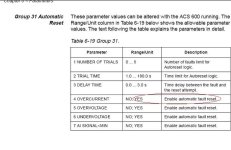mrdegold
Lifetime Supporting Member
Hello
I have multiple extruders that use 4-37KW 980 RPM 74 Amps 380Volt motors. This is attached to an appropriate Abb ACS 600 series Drive. The motor leads for this machine are all attached to the output of the drive then breakout to each motor through an overload set for 75 amps.
All parameters for the drives on multiple identical Extruders are the same except the extruder with the problem has parameter #31.04 which is under automatic resets section; it turns on or off automatic reset for OVERCURRENT alarms. This is turn off on the problem drive and the other running extruder has it turned on.
We completed a rebuild to the extruder gear box on June 2, 2009 and ran the extruder Starting June 8, 2009 we started to get OVERCURRENT faults on the drive. We could not find anything obvious our feeling is that the gearbox is running correctly. When trending the output of the drive we did not see the extruder running near current limit We amp probed all 4 motors and found one motor of the four was drawing about 10 more amps than the other 3 motors. We have another motor from a spare machine and on June 16, 2009 we replaced the motor. The extruder seem to run fine. All 4 motor loads seem within 1 to 2 amps.
Starting yesterday July 20, 2009 we started getting OVERCURRENT faults from the Extruder again. We see one motor drawing about 6 amps or so more than the other 3 motors. It is not the replacement motor that has the greater load.
The spare machine does have 2 more motors so I can change the motor.
But I have to wonder
How 2 motors from the same machine can go “a little bad”
Should I just expect to need to change all the remaining motors?
What do I tell the motor repair shop to look for while trying to fix the removed motors?
Could it be as simple as changing the 31.04 parameter and hopefully the drive will ride through the issue?
Can the current sensing “loop” of the drive go “soft”?
Can the current sensing “loop” of the drive be tested?
I am currently working on borrowed time. I am also getting some conflicting advice from my “circle of experts” and would greatly appreciate any thoughts, comments or idea’s you may have.
Thanks for the help
Michael
I have multiple extruders that use 4-37KW 980 RPM 74 Amps 380Volt motors. This is attached to an appropriate Abb ACS 600 series Drive. The motor leads for this machine are all attached to the output of the drive then breakout to each motor through an overload set for 75 amps.
All parameters for the drives on multiple identical Extruders are the same except the extruder with the problem has parameter #31.04 which is under automatic resets section; it turns on or off automatic reset for OVERCURRENT alarms. This is turn off on the problem drive and the other running extruder has it turned on.
We completed a rebuild to the extruder gear box on June 2, 2009 and ran the extruder Starting June 8, 2009 we started to get OVERCURRENT faults on the drive. We could not find anything obvious our feeling is that the gearbox is running correctly. When trending the output of the drive we did not see the extruder running near current limit We amp probed all 4 motors and found one motor of the four was drawing about 10 more amps than the other 3 motors. We have another motor from a spare machine and on June 16, 2009 we replaced the motor. The extruder seem to run fine. All 4 motor loads seem within 1 to 2 amps.
Starting yesterday July 20, 2009 we started getting OVERCURRENT faults from the Extruder again. We see one motor drawing about 6 amps or so more than the other 3 motors. It is not the replacement motor that has the greater load.
The spare machine does have 2 more motors so I can change the motor.
But I have to wonder
How 2 motors from the same machine can go “a little bad”
Should I just expect to need to change all the remaining motors?
What do I tell the motor repair shop to look for while trying to fix the removed motors?
Could it be as simple as changing the 31.04 parameter and hopefully the drive will ride through the issue?
Can the current sensing “loop” of the drive go “soft”?
Can the current sensing “loop” of the drive be tested?
I am currently working on borrowed time. I am also getting some conflicting advice from my “circle of experts” and would greatly appreciate any thoughts, comments or idea’s you may have.
Thanks for the help
Michael




